Catalogue: Satire
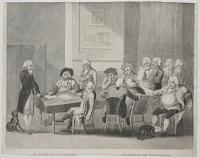
A Meeting of Creditors. Assemblée de Créanciers.
J. Boyne del.t. W. Nutter Sculp.t.
[1789.]
Stipple, scarce. Sheet: 525 x 410mm (20¾ x 16"). Trimmed within plate, publication line missing. Trimmed to image along top edge.
An accountancy scene showing a room in which a standing man is presented with several unpaid bills by a collection of disgruntled creditors. On the wall behind is a picture of Kings Bench Prison reminding the debtor and the audience of the punishment for debt. BM Satire 7615.
[Ref: 44266] £320.00
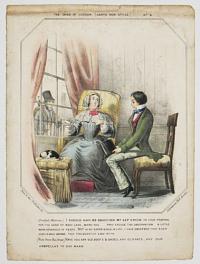
The Cries of London (Gents' New Style) No.6. (Prudent Mamma) I should have no objection Mr. Sap Green...
Dean & Son, Publishers, &c. 31, Ludgate Hill London.
Hand-coloured lithograph. Sheet: 300 x 220mm (11¾ x 8½''). Foxing.
An interior scene showing a middle aged woman in conversation with a young man who wishes to marry her daughter, from outside a peddlar calls through the window.
[Ref: 51097] £95.00
(£114.00 incl.VAT)
![[Thomas Rowlandson's 'Cries of London'.]](img-thumbnail/jpegs/51751.jpg)
[Thomas Rowlandson's 'Cries of London'.] Cries of London No. 1. Buy a Trap, a Rat Trap, buy my Trap. [&] No. 2. Buy my Goose, my fat Goose. [&] No. 3. Last dying Speech & Confession [&] No. 4. Do you want any brick-dust. [&] No. 5. Water Cresses, come buy my Water Cresses. [&] No. 6. All a growing, heres Flowers for your Gardens. [&] No. 7. Old Cloaths any Old Cloaths. [&] No. 8. Hot cross Bunns, two a penny Bunns.
Rowlandson Delin. Merke sculp.
London. Pub: Jan. 1st [- May 4th] 1799, at Ackermann's 101 Strand.
Set of eight aquatints with hand colour, large margins. Each c.350 x 290mm (13¾ x 11½"). Framed. Unexamined out of frame. Time stained.
A full set of Rowlandson's burlesque of Francis Wheatley's famous 'Cries' (1793-7), with the street traders both uptown and in less salubrious areas of London. BM Satire 9475-9480
[Ref: 51751] £2,000.00
view all images for this item
Unfortunately this item is either sold or reserved. If you are interested in similar items and cannot find what you're looking for on our website, please consider filling in our interests form. If you register, we can also send you items that match your interests when the website is updated.
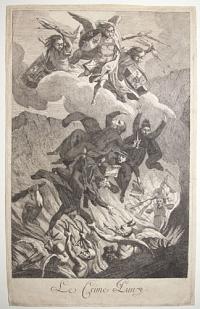
Le Crime Luny.
[n.d., c.1780.]
Rare etching. 430 x 265mm (17 x 10½") Small margins, wear to edges.
Three armoured angels, armed with swords and lightning bolts, drive a group of Catholic clergy into the pits of hell, where demons wait to drag them down. A satire on the corruption of the French church.
[Ref: 52986] £450.00
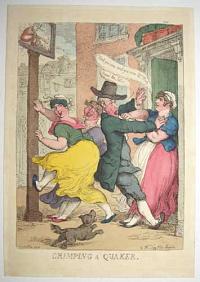
Crimping a Quaker.
Rowlandson 1814.
[Pub.d March 1st 1814] by Thos Tegg No 111 Cheapside [but later].
Fine coloured etching. 350 x 250mm (13½ x 10¾") Small margins.
Prostitutes try to hustle a Quaker into a brothel. One sings 'Wont you come, wont you come Mr Mug' (a popular song). BM: Satires 12401, this example with date erased.
[Ref: 61817] £320.00
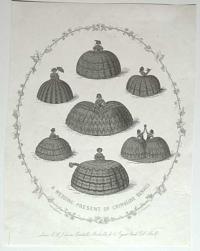
A Wedding Present Of Crinoline Service.
Lithographed by C.J. Culliford.
London, W. H. J. Carter, printseller, Bookseller, &c. 12, Regent Street, Pall Mall. [n.d. c.1850]
Very scarce lithograph, sheet 300 x 230mm (11¾ x 9"). Repaired tears.
A highly decorative satire on crinoline fashion, featuring 8 women in absolutely enormous skirts surrounded by an oval leaf border. W.H.J. Carter made a number of satires on crinoline publishing them annually. See also references 15161, 15159, 15153, 15154, 13109, 15160, 15165, 36835, 36836, 15352, 15353, 15354, 16831 & 42021.
[Ref: 61509] £180.00
(£216.00 incl.VAT)
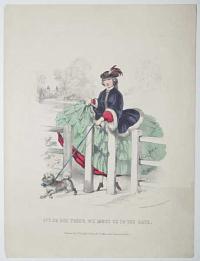
It's no use Tiney, we must go to the gate.
Lithographed by C.J. Culliford, 22, Southampton S.t Strand.
Published Nov.r 11.th by Mess.rs Fielding & C.o. 5, Melton Street, Euston Squ.e. London. [n.d. c.1858.]
Coloured lithograph, 380 x 285mm (15 x 11¼").
A satire on the mid 19th century fashion for crinolines. A woman walking her small dog is blocked by her crinoline dress going through a small passage in a fence.
[Ref: 60113] £140.00
(£168.00 incl.VAT)
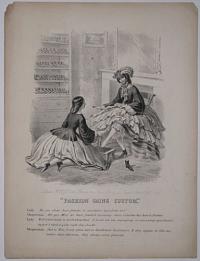
'Fashion Gains Custom.'
London W.H.J. Carter, Printseller, Bookseller &c. 12, Regent Street, Pall Mall.
Lithograph, sheet 380 x 285mm. 15 x 11¼". Facsimile mss. publisher's price list to verso, for '...Prints, Illustrative of Crinoline...beautifully coloured'.
A satire on the mid 19th century fashion for crinolines, from an annual series on that theme by the same publisher. A discussion in a shoe emporium between a fashionable young lady and the female shop assistant reveals a newly instigated policy that male assistants should not serve female customers, 'Since crinoline has been in fashion'. Crinoline was originally a stiff fabric with a weft of horse-hair and a warp of cotton or linen thread. The fabric first appeared around 1830, but by 1850 the word had come to mean a stiffened petticoat or rigid skirt-shaped structure of steel designed to support the skirts of a woman’s dress in the required shape. The crinoline was the subject of much ridicule and satire, particularly in Punch magazine. Dress reformers did not like it either — they seized upon the cage aspect of the crinoline and claimed that it effectively imprisoned women. Given that the crinoline did eventually have a maximum diameter of up to 180 centimetres (six feet), it is easy to imagine difficulties in getting through doors, in and out of carriages, and the general problems of moving in such a large structure. The second problem was the potential impropriety of the crinoline. Its lightness was a curse as well as a blessing, as a gust of wind or a knock could set it swinging and reveal the wearer's legs. Even worse, if a woman tripped or was knocked over, the crinoline would hold her skirts up.
[Ref: 15161] £180.00
(£216.00 incl.VAT)
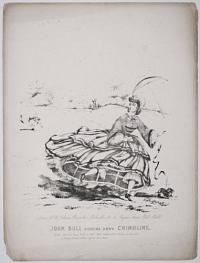
John Bull Running Down Crinoline.
London W.H.J. Carter, Printseller, Bookseller &c. 12, Regent Street Pall Mall.
Lithograph, sheet 380 x 285mm. 15 x 11¼". Tatty extremities, some spotting.
A satire on the mid 19th century fashion for crinolines, from an annual series on that theme by the same publisher. A lady and her toy spaniel (attempt to) run from a charging bull, her parasol falling from her hands. Crinoline was originally a stiff fabric with a weft of horse-hair and a warp of cotton or linen thread. The fabric first appeared around 1830, but by 1850 the word had come to mean a stiffened petticoat or rigid skirt-shaped structure of steel designed to support the skirts of a woman’s dress in the required shape. The crinoline was the subject of much ridicule and satire, particularly in Punch magazine. Dress reformers did not like it either — they seized upon the cage aspect of the crinoline and claimed that it effectively imprisoned women. Given that the crinoline did eventually have a maximum diameter of up to 180 centimetres (six feet), it is easy to imagine difficulties in getting through doors, in and out of carriages, and the general problems of moving in such a large structure. The second problem was the potential impropriety of the crinoline. Its lightness was a curse as well as a blessing, as a gust of wind or a knock could set it swinging and reveal the wearer's legs. Even worse, if a woman tripped or was knocked over, the crinoline would hold her skirts up.
[Ref: 15159] £160.00
(£192.00 incl.VAT)
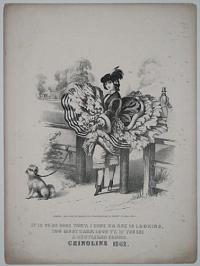
It is to be done Tiney; I hope no one is looking, You must bark loud Ty, If you see a Gentleman coming. Crinoline 1862.
London_W.H.J. Carter, Bookseller, Printseller, &c., 12, Regent St. Pall Mall.
Lithograph, sheet 380 x 280mm. 15 x 11".
A satire on the mid 19th century fashion for crinolines, from an annual series on that theme by the same publisher. A gust of wind lifts up the skirt of a young lady, revealing her underwear, to the evident delight of a gentleman on the path behind her. The lady's dog looks disgruntled, tethered to a fence. Crinoline was originally a stiff fabric with a weft of horse-hair and a warp of cotton or linen thread. The fabric first appeared around 1830, but by 1850 the word had come to mean a stiffened petticoat or rigid skirt-shaped structure of steel designed to support the skirts of a woman’s dress in the required shape. The crinoline was the subject of much ridicule and satire, particularly in Punch magazine. Dress reformers did not like it either — they seized upon the cage aspect of the crinoline and claimed that it effectively imprisoned women. Given that the crinoline did eventually have a maximum diameter of up to 180 centimetres (six feet), it is easy to imagine difficulties in getting through doors, in and out of carriages, and the general problems of moving in such a large structure. The second problem was the potential impropriety of the crinoline. Its lightness was a curse as well as a blessing, as a gust of wind or a knock could set it swinging and reveal the wearer's legs. Even worse, if a woman tripped or was knocked over, the crinoline would hold her skirts up.
[Ref: 15153] £140.00
(£168.00 incl.VAT)
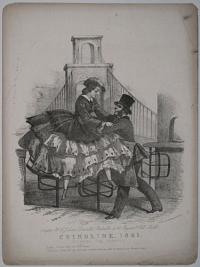
Crinoline 1861. Clearing the Barrier.
London W.H.J. Carter, Printseller, Bookseller, &c. 12, Regent St. Pall Mall. Printed at 22, Southampton St. Strand.
Lithograph, sheet 380 x 285mm. 15 x 11¼". Facsimile mss. publisher's price list to verso, for '...Prints, Illustrative of Crinoline...beautifully coloured'. Tatty extremities, creases through upper corners.
A satire on the mid 19th century fashion for crinolines, from an annual series on that theme by the same publisher. A lady is helped over turnstiles by a gentleman, a bridge, maybe Hammersmith Bridge, in the background. Crinoline was originally a stiff fabric with a weft of horse-hair and a warp of cotton or linen thread. The fabric first appeared around 1830, but by 1850 the word had come to mean a stiffened petticoat or rigid skirt-shaped structure of steel designed to support the skirts of a woman’s dress in the required shape. The crinoline was the subject of much ridicule and satire, particularly in Punch magazine. Dress reformers did not like it either — they seized upon the cage aspect of the crinoline and claimed that it effectively imprisoned women. Given that the crinoline did eventually have a maximum diameter of up to 180 centimetres (six feet), it is easy to imagine difficulties in getting through doors, in and out of carriages, and the general problems of moving in such a large structure. The second problem was the potential impropriety of the crinoline. Its lightness was a curse as well as a blessing, as a gust of wind or a knock could set it swinging and reveal the wearer's legs. Even worse, if a woman tripped or was knocked over, the crinoline would hold her skirts up.
[Ref: 15154] £180.00
(£216.00 incl.VAT)
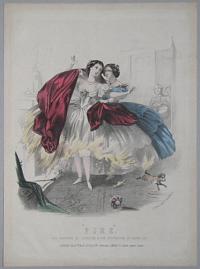
"Fire." The Horrors of Crinoline & the Destruction on Human Life.
L'Enfant, Imp, 18, Rathbone Pl.
Published the 14th. April. 1859 by, F.W. Farbrother, 5, Milton St. Euston Square, London.
Fine original hand coloured lithograph, sheet 375 x 275mm. 14¾ x 10¾".
A satire on mid 19th century female fashion; a young lady's dress has caught fire in an interior. Her terrier flees the scene with its tail on fire, an anxious servant with a bucket of water appears at a door in the background. Crinoline was originally a stiff fabric with a weft of horse-hair and a wrap of cotton or linen thread. The fabric first appeared around 1830, but by 1850 the word had come to mean a stiffened petticoat or rigid skirt-shaped structure of steel designed to support the skirts of a woman’s dress in the required shape. The crinoline was the subject of much ridicule and satire, particularly in Punch magazine. Dress reformers did not like it either — they seized upon the cage aspect of the crinoline and claimed that it effectively imprisoned women. Given that the crinoline did eventually have a maximum diameter of up to 180 centimetres (six feet), it is easy to imagine difficulties in getting through doors, in and out of carriages, and the general problems of moving in such a large structure. The second problem was the potential impropriety of the crinoline. Its lightness was a curse as well as a blessing, as a gust of wind or a knock could set it swinging and reveal the wearer's legs. Even worse, if a woman tripped or was knocked over, the crinoline would hold her skirts up.
[Ref: 13108] £130.00
(£156.00 incl.VAT)
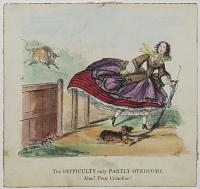
The Diddiculty only Partly Overcome. Alas! Poor Crinoline!
[n.d., c.1840.]
Lithograph with hand colour. Sheet 125 x 130mm (5 x 5¼"). Stain in title.
A woman escaping a bull catches her skirt. Her toy dog looks petrified.
[Ref: 51827] £65.00
(£78.00 incl.VAT)
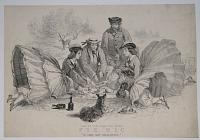
Pic Nic 'Is this not Delightful.'
London, W.H.J. Carter, 12 Regent Street_Pall Mall.
Lithograph, sheet 250 x 370mm. 9¾ x 14½". Sheet trimmed. Tear into image from right.
A satire on the mid 19th century fashion for crinolines, from a large series on that theme by the same publisher. The underwear of the three women enjoying the picnic is exposed by their rigid skirts as they lie on the grass. Crinoline was originally a stiff fabric with a weft of horse-hair and a warp of cotton or linen thread. The fabric first appeared around 1830, but by 1850 the word had come to mean a stiffened petticoat or rigid skirt-shaped structure of steel designed to support the skirts of a woman’s dress in the required shape. The crinoline was the subject of much ridicule and satire, particularly in Punch magazine. Dress reformers did not like it either — they seized upon the cage aspect of the crinoline and claimed that it effectively imprisoned women. Given that the crinoline did eventually have a maximum diameter of up to 180 centimetres (six feet), it is easy to imagine difficulties in getting through doors, in and out of carriages, and the general problems of moving in such a large structure. The second problem was the potential impropriety of the crinoline. Its lightness was a curse as well as a blessing, as a gust of wind or a knock could set it swinging and reveal the wearer's legs. Even worse, if a woman tripped or was knocked over, the crinoline would hold her skirts up.
[Ref: 15165] £140.00
(£168.00 incl.VAT)
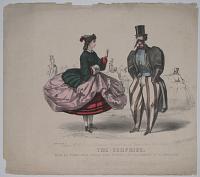
The Surprise. Dear Me Frank who would have thought of you Shewing Up in Crinoline?
Copyright. London, W.H.J. Carter, Printseller, Bookseller &c. 12, Regent Street, Pall Mall.
Hand coloured lithograph, sheet 290 x 325mm. 11½ x 12¾". Facsimile mss. publisher's price list to verso, for '...Prints, Illustrative of Crinoline...beautifully coloured'. Tatty extremities, tear from right.
A satire on the mid 19th century fashion for crinolines, from an annual series on that theme by the same publisher. Here the artist envisages a male equivalent. Crinoline was originally a stiff fabric with a weft of horse-hair and a warp of cotton or linen thread. The fabric first appeared around 1830, but by 1850 the word had come to mean a stiffened petticoat or rigid skirt-shaped structure of steel designed to support the skirts of a woman’s dress in the required shape. The crinoline was the subject of much ridicule and satire, particularly in Punch magazine. Dress reformers did not like it either — they seized upon the cage aspect of the crinoline and claimed that it effectively imprisoned women. Given that the crinoline did eventually have a maximum diameter of up to 180 centimetres (six feet), it is easy to imagine difficulties in getting through doors, in and out of carriages, and the general problems of moving in such a large structure. The second problem was the potential impropriety of the crinoline. Its lightness was a curse as well as a blessing, as a gust of wind or a knock could set it swinging and reveal the wearer's legs. Even worse, if a woman tripped or was knocked over, the crinoline would hold her skirts up.
[Ref: 15160] £190.00
(£228.00 incl.VAT)

It is to be done Tiney; I hope no one is looking, You must bark loud Ty, If you see a Gentleman coming. Crinoline 1862.
London_W.H.J. Carter, Bookseller, Printseller, &c., 12, Regent St. Pall Mall.
Very fine original hand coloured lithograph, sheet 315 x 255mm. 12½ x 10". Trimmed to image top and sides.
A satire on the mid 19th century fashion for crinolines, from an annual series on that theme by the same publisher. A gust of wind lifts up the skirt of a young lady, revealing her underwear, to the evident delight of a gentleman on the path behind her. The lady's dog looks disgruntled, tethered to a fence. Crinoline was originally a stiff fabric with a weft of horse-hair and a warp of cotton or linen thread. The fabric first appeared around 1830, but by 1850 the word had come to mean a stiffened petticoat or rigid skirt-shaped structure of steel designed to support the skirts of a woman’s dress in the required shape. The crinoline was the subject of much ridicule and satire, particularly in Punch magazine. Dress reformers did not like it either — they seized upon the cage aspect of the crinoline and claimed that it effectively imprisoned women. Given that the crinoline did eventually have a maximum diameter of up to 180 centimetres (six feet), it is easy to imagine difficulties in getting through doors, in and out of carriages, and the general problems of moving in such a large structure. The second problem was the potential impropriety of the crinoline. Its lightness was a curse as well as a blessing, as a gust of wind or a knock could set it swinging and reveal the wearer's legs. Even worse, if a woman tripped or was knocked over, the crinoline would hold her skirts up.
[Ref: 13109] £180.00
(£216.00 incl.VAT)
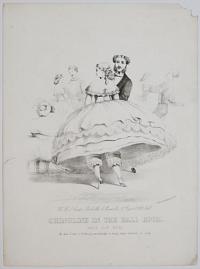
Crinoline in the Ball Room. Valse Ala Mode. My dear Tiney is Fretting exceedingly at being kept Solitary so long.
C.J. Culliford, lith. Southampton S.t. Strand.
W.H.J. Carter, Bookseller & Printseller, 12 Regent S.t. Pall Mall.
Lithograph. Sheet: 280 x 380mm, (11 x 15"). Damage to top right corner. Repaired tear in left edge. Some marks.
A scene in a ballroom depicting a young woman in an extremely large crinoline dancing with a young man, behind them are two other couples.
[Ref: 36835] £140.00
(£168.00 incl.VAT)
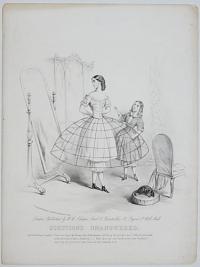
Questions Unanswered. Little Sister Fanny, (Loquitur) "Clara, are these the Hoops the Ethiopians call Hoop de dooden do."_Why do you make yourself look so like a Ballon?_Why does pa say I shall never wear Crinoline?. and why do you never take Tiney in the Carriage now.
Lithographed & Printed by C.J. Calliford, 22, Southampton S.t., Strand.
London, Published by W.H.J. Carter, Book & Printseller, 12, Regent S.t. Pall Mall.
Lithograph. Sheet: 285 x 380mm, (11¼ x 15"). Some slight damage to corners and edges.
Scene in a bedroom in which a young girl questions her older sister, who stands looking at herself in a dressing mirror, about her crinoline.
[Ref: 36836] £140.00
(£168.00 incl.VAT)
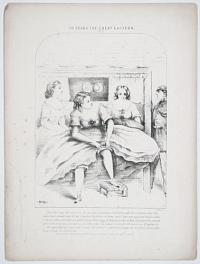
"On Board the Great Eastern" No. 3. But that aint the worst of it; the doors are all painted so beautiful, and look so romantic, that they didn't like to number them...
SEM-
London W.H.J. Carter, Printseller, Bookseller &c. 12, Regent Street, Pall Mall. [n.d., c.1860.]
Lithograph. Printed area 310 x 200mm, 12¼ x 8". Some wear and soiling.
[Ref: 15354] £180.00
(£216.00 incl.VAT)
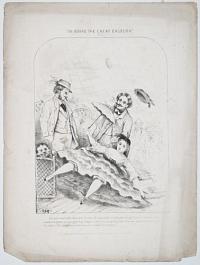
"On Board the Great Eastern" No. 2. You aint much better off on deck, for when the ship pitches or rolls, you are apt to lose your stool...
SEM-
London W.H.J. Carter, Printseller, Bookseller &c. 12, Regent Street, Pall Mall. [n.d., c.1860.]
Lithograph. Printed area 310 x 200mm, 12¼ x 8". Some wear and soiling.
A satire on crinolines on luxury passenger ships, with a woman keeling over, to the amusement of the watching men. With a catalogue of crinoline satires available from Carter on verso. Brunel's Great Eastern was launched in 1858, but was damaged by an explosion on her maiden voyage. After only a half-dozen years as a passenger ship she was converted to a cable-laying ship, laying the first lasting transatlantic telegraph cable in 1866.
[Ref: 15353] £180.00
(£216.00 incl.VAT)
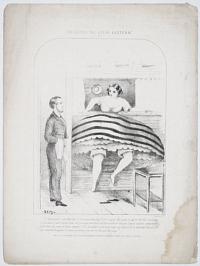
"On Board the Great Eastern" No. 1. To dismount is another feat of horsemanship only fit for a sailor...
SEM-
London W.H.J. Carter, Printseller, Bookseller &c. 12, Regent Street, Pall Mall. [n.d., c.1860.]
Lithograph. Printed area 310 x 200mm, 12¼ x 8". Some wear and soiling.
A satire on crinolines in the confines of luxury passenger accommodation, with a woman climbing down from a bunk, watched by a steward. With a catalogue of crinoline satires available from Carter on verso. Brunel's Great Eastern was launched in 1858, but was damaged by an explosion on her maiden voyage. After only a half-dozen years as a passenger ship she was converted to a cable-laying ship, laying the first lasting transatlantic telegraph cable in 1866.
[Ref: 15352] £180.00
(£216.00 incl.VAT)
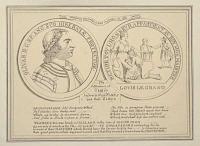
The difference of Times between those Times and these Times.
[n.d., c.1800.]
Rare etching. Sheet 195 x 270mm (7¾ x 10½"), on wove paper. Trimmed and mounted in album paper watermarked 1819.
A copy of a satirical medal struck in the Netherlands circa 1655 to ridicule the subservience of the French and Spanish kings to Oliver Cromwell. The 'heads' side has a roundel portrait of Cromwell in armour; the 'tails' has Cromwell kneeling with his head on Britannia's lap, his bottom exposed for them to kiss. A re-engraved copy of a print from c.1739. See BM Satires 894 & 2417.
[Ref: 61154] £160.00
(£192.00 incl.VAT)
![[Dog and the Lion Dance.] Dogg en Leeuwen-Dans.](img-thumbnail/jpegs/42930.jpg)
[Dog and the Lion Dance.] Dogg en Leeuwen-Dans.
[n.d., c.1658.]
Illustrated broadside, very scarce. Sheet: 380 x 280mm (15 x 11"). Damaged with large repaired tears below image right. Trimmed and laid on album sheet.
A Dutch satirical print commenting on Oliver Cromwell's rule of Britain and his relationship with the Netherlands. Cromwell, wearing the triple crown is shown standing on a tattered royal standard while leading two men with chains, to his right a Spaniard points out of a window at two ships. To the right the Dutch Lion raises a sword topped with the cap of Liberty, while some Dutchmen stand behind him. Above are three scenes, the central shows the Dutch Lion attacking Cromwell, on the left the figures of Liberty and Justice hand Charles II the sceptre and on the right Liberty frees two imprisoned men.
[Ref: 42930] £750.00
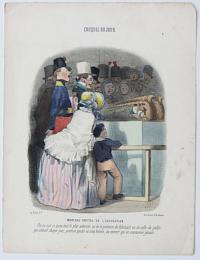
Morceau Capital de L'Exposition. On ne sait ce qu'on doit le plus admirer, ou de la patience du fabricant ou de celle du public qui attend chaque jour, pendant quatre ou cinq heurres, au concert que ne commence jamais.
[G. Vennier facsimile signature] Imp. Aubert & Co.
Chez Aubert, Pl. de la Bourse [n.d., c.1850].
Hand-coloured lithograph. Sheet size: 357 x 270mm (13¾ x 10½"). Scuffing to sheet. Small tear in lower edge of sheet. Crease to lower right corner.
Plate number 6 from the French, 'Croquis du Jour' or 'Sketch of the Day' series. A group of well dressed figures gathered around a row of squirrels with instruments, patiently waiting for them to start playing.
[Ref: 32192] £160.00
(£192.00 incl.VAT)
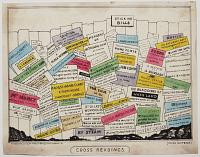
Cross Readings. (Price Sixpence).
Printed and sold by W. Jeffrey 7 Geo:e Y.d Lombard St. [n.d., c.1840.]
Rare hand-coloured lithograph. Sheet: 230 x 290mm (9 x 11½''). Staining at edges.
A satirical print showing broadsides pasted on a fence, though the broadsides are not connected they seems to run into each other in a comical fashion, for example 'N.B. Shortly will be exhibited for Public inspection the arms, legs &c''of Mrs. Honey who has kindly consented to''Rise Rapidly''No charge for inspection'. Other references are made to ballooning, performances at Covent Garden, steam ships, Jim Crow, punishment, tigers and kangaroos. For another version see 32271.
[Ref: 48938] £360.00
![[Cross Readings]](img-thumbnail/jpegs/53283.jpg)
[Cross Readings]
[n.d., c.1835.]
Ink and watercolour. Sheet 265 x 225mm (10½ x 9").
A fence covered with overlapping bills, positioned for humorous effect. For example one column begins: 'Important Notice - Mess.rs Christie and Manson respectfully inform the public that they are - [exh]ibiting Daily. Ojibbeway Indians'. Above the fence is a swivel cannon, designed to repel boarders. 'The singing mouse whose extraordinary performance in his'.
[Ref: 53283] £280.00
(£336.00 incl.VAT)
![[Cross Readings]](img-thumbnail/jpegs/32271.jpg)
[Cross Readings]
[Anon, c.1830]
Lithograph with hand-colouring, sheet 205 x 280mm (8 x 11"). Trimmed to border and glued to backing sheet.
'Cross Readings' were a curious Victorian print genre depicting a palimpsest of notices pasted against fences so they could be read downwards as complete sentences. These prints both anticipated Surrealist techniques and recorded the interests and events of the period. This print includes references to ballooning, steam transport, entertainment, punishment and trade. An example sentence is 'Mr. G. Robins will / on Monday next at twelve o'clock precisely Swallow / 8 fine male elephants three Kangaroos and an enormous Bengal Tigress / Without Reserve The Proprietor retiring from Swallow Street.' Australian interest. for another version of this image see ref. 14145
[Ref: 32271] £180.00
(£216.00 incl.VAT)
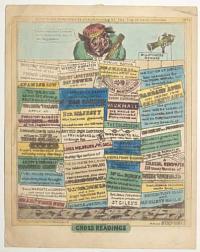
Cross Readings. To be read downwards, commencing at the Top of each column.
E.S. Hall.
Printed & sold by W. Jeffrey 7 Geo. Yard Lombard St. Price Sixpence [n.d., c.1850.]
Scarce coloured lithograph. Sheet 310 x 245mm (12¼ x 9¾").
A fence covered with overlapping bills, positioned to be read for humourous effect. An example reads 'Her Majesty who has been graciously pleased to say she will take' ... 'Any Old Iron Saucepans or Frying Pans in exchange for' ... 'Lords Melbourne and Russell'. Top right is a swivel cannon, designed to repel boarders, with a sign 'Bill stickers beware'. Looking over the fence is a grotesque man saying 'Tunder and Turf, I should just like to cotch one o' the Wagabones'. 'The Chinese Saloon the celebrated Jugglers ..'. See 12598 for an earlier version.
[Ref: 60763] £280.00
(£336.00 incl.VAT)
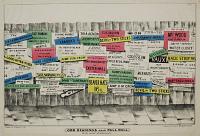
Odd Readings Near Pall Mall. to be read downwards.
Drawn on Stone, by I.S.M.
Printed by W. Clerk 202 High Holborn. [n.d., c.1838.]
Rare hand coloured lithograph. Sheet 220 x 325mm (8¾ x 12¾". Trimmed, laid on album paper at corners, crease in top edge.
A London fence covered with overlapping advertisements and theatre bills, arranged for humorous effect. For example ''To be Sold by Auction / Mad.lle Duvernay's / Finely Carved Legs, &c''.
[Ref: 51581] £230.00
(£276.00 incl.VAT)
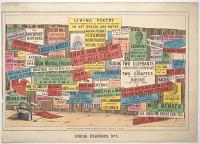
Cross Readings No 3.
London. W.H.J. Carter, Printseller, Bookseller, &c. 12 Regent St, Pall Mall. [n.d., c.1864.]
Coloured lithograph. Sheet 300 x 420mm (11¾ x 16½"). Narrow left margin with chip affecting printed border.
A fence covered with overlapping bills, positioned to be read for humourous effect. An example reads ''Cremorne Godard's Monstre Baloon will ascend carrying / Two Elephants a Rhinoceros, Hippopotamus and Two Giraffes just arrived from Dahomey''. London's first hot-air balloon ascent was by Eugène Godard in 1864, who flew 'L'Aigle' from Cremorne Gardens to Greenwich. He later piloted Jules Verne on the author's only balloon flight. For similar see Refs: 51582, 53283, 53284, 45764
[Ref: 54548] £280.00
(£336.00 incl.VAT)
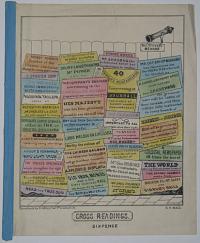
Cross Readings. Sixpence.
E.S. Hall.
Printed & sold by W. Jeffery 7 Geoe: Yd. Lombard St: [n.d., c.1840.]
Hand coloured lithograph, sheet 300 x 250mm, 11¾ x 9¾". Tear into upper image. Damage to extremity upper right and two tears.
A fence covered with overlapping advertisements and theatre bills, arranged for humorous effect.
[Ref: 12598] £180.00
(£216.00 incl.VAT)
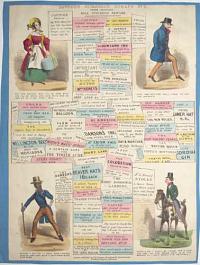
Dawson's Humorous Scraps No 9. Cross Readings. Bill Stickers Beware.
Printed by L.M. Lefevre, Newman Street.
London. Published by Tho.s Dawson, 29 Bedford St. Covent Garden. [n.d., c.1840.]
Very fine coloured lithograph. Sheet 380 x 280mm (15 x 11"). Laid on album paper at corners.
A fence covered with overlapping bills, positioned to be read for humourous effect. An example reads ''Her Majesty's most gracious Pardon will be Granted to any Person who will / Abuse or in any way ill use / The New Police''. This example differs from the usual 'Cross Readings' by having an illustrated satire about bills in each corner. The one bottom left combines racism with an advert for another of the the publisher's products, 'Dawson's Ink. An actor reads an advert for the ink, which is described as 'a beautiful rich black which will never fade'; he exclaims 'Never!! I did try it once when I played Othello and have been a confirmed black ever since'.
[Ref: 57702] £280.00
(£336.00 incl.VAT)
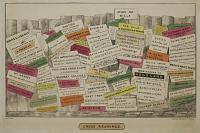
Cross Readings.
E.S. Hall. Bellamy lith, 26 G.t. S.t Helens.
[n.d., c.1840's.]
Rare coloured lithograph. Sheet 225 x 340mm (9 x 13½"). Trimmed to printed border, laid on album paper at corners.
A fence covered with overlapping bills, positioned for humorous effect. An example reads 'The Royal Nassau Balloon will again ascend from Vauxhall, taking up... Four Acres Arable Land A Farm House 2 Hackney Coaches... A four Post Bed...". Another starts "Lunardi who journey'd in a Balloon to the Moon..."
[Ref: 51582] £230.00
(£276.00 incl.VAT)
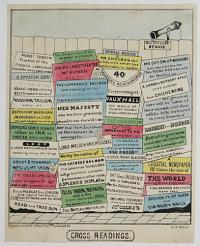
Cross Readings.
E.S. Hall.
Printed & sold by W. Jeffrey 7 Geo:e Y.d Lombard St. [n.d., c.1840.]
Rare fine hand-coloured lithograph. Sheet: 275 x 220mm (11 x 8¾'').
A satirical print showing broadsides pasted on a fence, though the broadsides are not connected they seems to run into each other in a comical fashion, for example 'Lost: A Lady's Memorandum Book containing among other things''About 1 ton & Half Wrought Iron'; 'the Company's Engines now running on the Birmingham Railway'; The Colosseum, 'Vauxhall Ducrow's valuable Stud of Horses'.
[Ref: 48908] £230.00
(£276.00 incl.VAT)
![[A 'cross readings' satire.]](img-thumbnail/jpegs/45764.jpg)
[A 'cross readings' satire.]
[n.d., c.1840.]
Coloured lithograph. Sheet 285 x 230mm (11½ x 9"). Wear to edges.
A fence covered with overlapping bills, positioned to be read for humourous effect. An example reads 'Her Majesty who has been graciously pleased to say she will take' ... 'Any Old Iron Saucepans or Frying Pans in exchange for' ... 'Lords Melbourne and Russell'.
[Ref: 45764] £260.00
(£312.00 incl.VAT)
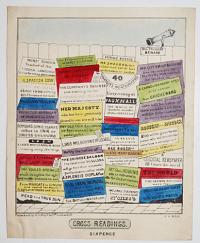
Cross Readings.
E.S. Hall.
Printed & sold by W. Jeffrey 7 Geo:e Y.d Lombard St. [n.d., c.1840.]
Coloured lithograph. Sheet 300 x 240mm (11¾ x 9½"). Laid on album paper.
A fence covered with overlapping bills, positioned to be read for humourous effect. An example reads 'Her Majesty who has been graciously pleased to say she will take' ... 'Any Old Iron Saucepans or Frying Pans in exchange for' ... 'Lords Melbourne and Russell'. Above the fence is a swivel cannon, designed to repel boarders. 'Drury Lane Theatre Mr. Power' 'A cargo off Barbary Apes just landed from Chichewang'. See 12598 for different colouring.
[Ref: 53284] £240.00
(£288.00 incl.VAT)
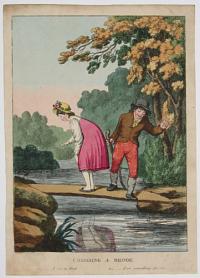
Crossing a Brook. She_ I see a Fish He_ I see something else.
[Anon., c.1820.]
Etching with hand-colouring, sheet 325 x 230mm (12¾ x 9"). Trimmed; tear lower left.
A young couple on a makeshift bridge over a stream. The woman looks into the water and sees a fish while the man uses the reflection in the water to look up her dress.
[Ref: 41477] £260.00
(£312.00 incl.VAT)
![The Crown and Anchor Desper[d]ado or the Cracked Member belonging to the Bedlam Ranger.](img-thumbnail/jpegs/50839.jpg)
The Crown and Anchor Desper[d]ado or the Cracked Member belonging to the Bedlam Ranger.
[Charles Williams.]
Pub.d Aug.t 8.th 1803 by S.W. Fores 50 Piccadilly. Folios of Caricatures let out for the Evening.
Hand-coloured etching. Sheet: 250 x 335mm (9¾ x 13''). Trimmed to image and creased.
A political satire commenting on a speech made at the Crown & Anchor tavernby Sir Francis Burdett on his re-election. In his speech he criticised the government and questioned why soldiers and sailors would volunteer to fight as they were not given just reward. Burdett is shown hanging out of a window while a crowd of disgruntled sailors and soldiers listen to him speak. BM Satire 10054.
[Ref: 50839] £260.00
(£312.00 incl.VAT)
![[Lithographic designs by George Cruikshank, signed by the artist]](img-thumbnail/jpegs/41113.jpg)
[Lithographic designs by George Cruikshank, signed by the artist] Reissue of Scraps & Sketches by George Cruikshank in Monthly Parts Half a Crown [...]
[George Cruikshank, c.1854]
86 Fleet Street W. Kent & Co Late David Bogue
Lithograph, 270 x 360mm (10½ x 14¼"). Glued to backing sheet, wormhole bottom left; frontispiece to Cruikshank's 'Illustrations of Time' verso. Inscribed 'To the Editor of the Morning Post with the compliments of George Cruikshank'
'About 1854 Cruikshank intended to publish "Re-issue of Scraps and Sketches in monthly parts...to be completed in ten parts." [...] For this issue the artist executed a lithographic design for the wrappers, and the work was published by "W. Kent & Co., late Bogue" (Cohn). Cohn 180
[Ref: 41113] £160.00
(£192.00 incl.VAT)
view all images for this item

[Signature of Robert Cruikshank Sept 12, 1863 to "Richard Fisher Esq" in ink maybe a member of the publishing house "H. Fisher & Son"with ink mss. invitation illustration To "Mr. Woodwend's".] Mr G.H. Virtue, at Home... Tues May 26th "Ethereal Material"
Sep.t 12th 1865.
Two sheets: invitation 95 x 135 (3¾ x 5¼"), signature 150 x 180mm (6 x 7"), with boar's head blindstamp and Cruikshank's signature. Laid on album paper.
[Ref: 54490] £390.00
![[Seven vignette satires of bonnets on one sheet.]](img-thumbnail/jpegs/51595.jpg)
[Seven vignette satires of bonnets on one sheet.]
Drawn Etched & Published by George Cruikshank ~
May 20th 1829.
Etching. Sheet 255 x 365mm (10 x 14½"). Spotting.
Seven satires on ladies' hats, including: 'Bonnet Building', featuring four milliners, two on tall step-ladders, trimming a hat far larger than themselves with giant bows of ribbon; and 'Section of the Bonnet Carriage', depicting a carriage shaped accomodate her hat and her bustle. From the series 'Scraps and Sketches'. BM Satires 15617.
[Ref: 51595] £75.00
(£90.00 incl.VAT)
![[Nine vignette satires on one sheet.]](img-thumbnail/jpegs/51597.jpg)
[Nine vignette satires on one sheet.]
Drawn Etched & Published by George Cruikshank ~
Nov.r 1st 1829.
Etching. Sheet 255 x 365mm (10 x 14½").
Nine random satires, including 'Lithography', a pun showing a beggar drawing on a pavement. Plate 6 from the series 'Scraps and Sketches' BM Satires 15982.
[Ref: 51597] £120.00
(£144.00 incl.VAT)
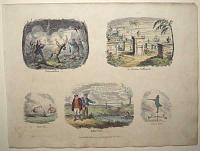
Preservation. An African Settlement. Spoon=bill. Botheration. A Vane Man.
Designed Etched & Published by George Cruikshank
Feb.y 1 1831.
Etching with original hand colour. Sheet 265 x 355mm (10½ x 14"). Small tears in bottom edge, some slight staining.
Five vignette drolls. 'Preservation' has hunters shooting each other rather than the pheasants; 'An African Settlement' shows a graveyard. From the series 'Scraps and Sketches'.
[Ref: 57283] £140.00
(£168.00 incl.VAT)
![[Nine vignette satires on one sheet.]](img-thumbnail/jpegs/57286.jpg)
[Nine vignette satires on one sheet.]
Drawn Etched & Published by George Cruikshank ~
Nov.r 1st 1829.
Etching with original hand colour. Sheet 255 x 365mm (10 x 14½"), watermarked 'Whatman Turkey Mill, 1829). Tear through vignette top left.
Nine random satires, including 'Lithography', a pun showing a beggar drawing on a pavement. Plate 6 from the series 'Scraps and Sketches' BM Satires 15982.
[Ref: 57286] £140.00
(£168.00 incl.VAT)
![[Seven vignette satires on one sheet.]](img-thumbnail/jpegs/57290.jpg)
[Seven vignette satires on one sheet.]
Drawn Etched & Published by George Cruikshank ~
May 20th 1828.
Etching with hand colour. Sheet 255 x 365mm (10 x 14½"). Some staining.
Seven vignette satiresm including 'Brobdignag Bonnet', showing a woman with a massive hat. From the series 'Scraps and Sketches'.
[Ref: 57290] £160.00
(£192.00 incl.VAT)
![[Six vignette satires on one sheet.]](img-thumbnail/jpegs/51598.jpg)
[Six vignette satires on one sheet.]
Drawn Etched & Published by George Cruikshank ~
May 20th 1828.
Etching. J. Whatman 1827 watermark; Sheet 255 x 365mm (10 x 14½").
Nine random satires, including 'Johnny Cockaigne showing Cousin Tummas a "Lions" den', a view of William Crockford's 'St James's Club', St James's Street. Plate 4 from the series 'Scraps and Sketches'. BM Satires 15620.
[Ref: 51598] £60.00
(£72.00 incl.VAT)
![[Seven vignette satires on one sheet.]](img-thumbnail/jpegs/51599.jpg)
[Seven vignette satires on one sheet.]
Drawn Etched & Published by George Cruikshank ~
May 20th 1828.
Etching. Sheet 255 x 365mm (10 x 14½").
Seven random satires, including: 'A Jolly Companion', a bust profile of a man constructed from a punch bowl, decanter, two glasses, lemon, lemon-squeezer and corkscrew; and 'Tooth Powder' showing a sufferer from tooth-ache extracting a tooth by firing a pistol, the bullet attached by a string to the tooth. Plate 1 from the series 'Scraps and Sketches'. BM Satires 15619.
[Ref: 51599] £60.00
(£72.00 incl.VAT)
![[Five vignette legal scenes on one sheet.]](img-thumbnail/jpegs/51601.jpg)
[Five vignette legal scenes on one sheet.] "Pleading at the Bar." or - Popular Education - a Farce. Performed every Sessions.
Drawn Etched & Published by George Cruikshank ~
May 20th 1828.
Etching. Sheet 255 x 365mm (10 x 14½"). Some spotting.
Four legal satires around a central realistic rendering of an Old Bailey trial, including: 'Chamber Practice', in which young lawyers carouse drunkenly; and 'Practising at the Bar', depicting a burglar using a crow-bar to jimmy open a shutter of a bar (pub) door. From the series 'Scraps and Sketches'. BM Satires 15621.
[Ref: 51601] £130.00
(£156.00 incl.VAT)
![[Seven vignette satires of wooden legs on one sheet.]](img-thumbnail/jpegs/51600.jpg)
[Seven vignette satires of wooden legs on one sheet.]
Drawn Etched & Published by George Cruikshank ~
May 20th 1828.
Etching. Sheet 255 x 365mm (10 x 14½"). Spotting.
Seven satires on wooden legs, including: 'A Gentlemans rest broken in consequence of going to bed with his leg on –', in which a chambermaid mistakes a sailor's leg for the handle of the warming pan; and 'Living on Wooden Legs, with four stilt walkers. From the series 'Scraps and Sketches'. BM Satires 15617.
[Ref: 51600] £60.00
(£72.00 incl.VAT)
![[Five vignette satires on one sheet.]](img-thumbnail/jpegs/51603.jpg)
[Five vignette satires on one sheet.]
Drawn Etched & Published by George Cruikshank ~
Nov.r 1 1829.
Etching. Sheet 255 x 365mm (10 x 14½"). Some spotting.
Five including: 'Church & State'—', in which a bishop and a layman take wine together at a dinner-table under a gas chandelier, while three bloated footmen attend. BM Satires 15980.
[Ref: 51603] £75.00
(£90.00 incl.VAT)


![[Thomas Rowlandson's 'Cries of London'.]](img-thumbnail/jpegs/51751.jpg)



















![[Dog and the Lion Dance.] Dogg en Leeuwen-Dans.](img-thumbnail/jpegs/42930.jpg)


![[Cross Readings]](img-thumbnail/jpegs/53283.jpg)
![[Cross Readings]](img-thumbnail/jpegs/32271.jpg)







![[A 'cross readings' satire.]](img-thumbnail/jpegs/45764.jpg)


![The Crown and Anchor Desper[d]ado or the Cracked Member belonging to the Bedlam Ranger.](img-thumbnail/jpegs/50839.jpg)
![[Lithographic designs by George Cruikshank, signed by the artist]](img-thumbnail/jpegs/41113.jpg)

![[Seven vignette satires of bonnets on one sheet.]](img-thumbnail/jpegs/51595.jpg)
![[Nine vignette satires on one sheet.]](img-thumbnail/jpegs/51597.jpg)

![[Nine vignette satires on one sheet.]](img-thumbnail/jpegs/57286.jpg)
![[Seven vignette satires on one sheet.]](img-thumbnail/jpegs/57290.jpg)
![[Six vignette satires on one sheet.]](img-thumbnail/jpegs/51598.jpg)
![[Seven vignette satires on one sheet.]](img-thumbnail/jpegs/51599.jpg)
![[Five vignette legal scenes on one sheet.]](img-thumbnail/jpegs/51601.jpg)
![[Seven vignette satires of wooden legs on one sheet.]](img-thumbnail/jpegs/51600.jpg)
![[Five vignette satires on one sheet.]](img-thumbnail/jpegs/51603.jpg)